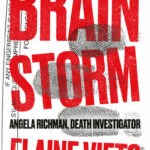By Elaine Viets
My agent just sent me his suggestions for rewrites on my fourth Angela Richman mystery. Most of his criticisms were about dialogue: it was too long, too wooden, a speech turned into a rant. Based on his critique, I developed these dialogue tips:
Six Dialogue Tips By Elaine Viets
(1) Listen to How People Talk
Go to a bar, restaurant or a coffee shop or a McDonald’s and listen to conversations. I love to eavesdrop on conversations. They help me pick up the rhythm of real speech – and sometimes I hear things I can use. Like the man at the bar who talked to his friend about how to kill his wife. They discussed various fatal scenarios until he finally concluded that he should “accidently” push her radio off the shelf into water when she was in the tub. I was about to call the police when I realized the two men were plotting a novel.
(2) Don’t be too realistic
People say “uh,” and “er” and rarely speak perfectly. They interrupt one another. You need to make your dialogue believable without making it absolutely realistic.
(3) Beware of stereotypes and accents
If your character speaks with an accent, point it out for a sentence or two: He spoke with a heavy Russian accent – but don’t make your readers wade through it for pages.
(4) Cut the small talk
You don’t need all those hellos and good-byes. Normally, they add nothing to the story. If your scene starts with a wife coming home from work and it begins this way:
“Hi,” she said.
“How are you?” he asked. “How was your day?”
Skip the hellos and start with “How was your day?” And let us know if the couple kiss. That could be a key to their marriage.
(5) Break up the dialogue with action
If two characters are talking over breakfast, have them pour syrup on their pancakes, sugar their coffee and cut up their bacon between sentences.
(6) Avoid dialogue tags
She sputtered. He chortled. She raged. He observed. She exclaimed. He interjected. She purred. These are all dialogue tags. Now forget them.
Dialogue tags attribute a line of dialogue to one or other of the characters, so that the reader always knows who is speaking. Tags should be invisible.
All you need are “he said” and “she asked.”
(7) Avoid the “You know, Jim,” syndrome
That’s an information dump disguised as regular dialogue: “You know, Jim, if you want a tax break, equipment that qualifies for the Residential Renewable Energy Tax Credit includes solar, wind, geothermal and fuel-cell technology.” Nobody talks like that in casual conversation – not even a salesperson.
*****************************************************************************************
Read forensic mysteries? You need BRAIN STORM, the first novel in my Angela Richman, Death Investigator series. Now 99 cents. https://tinyurl.com/yyuy2429









Excellent tips, Elaine! When dialogue is too on-the-nose, it ruins the story for me.
Agreed, Sue. It’s a fine line for writers to walk.
Excellent tips, especially the first one. I used to tell writers to sit in Denny’s late at night (when cops, lawyers, hobos, et al congregate) and take surreptitious notes. (grin) And most of my tips ended up in my book, titled (you guessed it) Writing Realistic Dialogue, which won 4th place for Book of the Year at the BEA in New York one year in the Education category.
Congratulations on your award, Harvey. I lost my taste for the local Denny’s after I saw a fat rat run across the parking lot. I hoped it was just visiting.
I love teaching dialogue, and these tips are all sound. You’ll also find you can cut a lot of beginning words. Example:
“Want to go to the store?”
“Yes, but let’s stop by the bar first.”
Better:
“Want to go to the store?”
“Let’s stop by the bar first.”
Excellent example, Jim.
Would replacing “want to” with “wanna” be okay? Or, is that too realistic?
I use “wanna” and “gonna” whenever it sounds right for the character.
I’m with Jim. If my character is educated, I would not use “wanna.” I do use it if it fits him.
Great tips, Elaine.
I consider “he said” a dialogue tag, but as you said, that one’s invisible. I remember reading a Robert B. Parker years ago, and realized that although he tagged almost every line of dialogue with “said”, I hadn’t noticed any of them.
It’s what my editor calls “saidisms” that jump off the page. And lets not get started on the “Tom Swifty” adverbs that tell the reader how the words were spoken. “I’m. sorry,” he said apologetically.
Your #5, I’ve heard referred to as “beats” or “action tags.”
Another pitfall is the phone conversation. Readers will understand the “Hello, Sam. This is Joe” bits without needing them on the page.
Following dialogue is one of the things I catch on my nightly reads on my scene printouts. If I can’t tell who’s talking, I add a beat or tag. If I can follow the conversations, I might remove some. My brain seems to be able to handle no more than 4 instances of unattributed dialogue. After that, I have to go back and re-read.
“No, Tom Swifties,” I said, quickly. Telephone conversations are another pitfall for we writers.
Dialogue has always been the easiest for me, but I’ve noticed when reading unfinished manuscripts that it’s number 5 that ruins most of them. Namely, the lack of action, the lack of movement. Their dialogue is decent enough, but it runs into wooden because the character feel like statues just spouting words across the room at each other.
Another trick I used to do when I was starting out is to recreate real conversations in my head. I started doing it just out of curiosity to find out how we got on a certain thread of conversation, but it helped internalize the pattern of dialogue too. Also a great way to figure out a person’s real intentions. Also listening in on a phone conversation, and trying to figure out who the person is talking to based on how they say things and what they say.
I like both those tips, AZAli. Also, it gives me more excuses to eavesdrop — in the line of duty, of course.
Elaine, #1 reminded me of a true incident.Two writer pals (one is a doctor) and I were deep in conversation in a coffee shop discussing what drug to slip into the victim’s IV that wouldn’t show on a tox screen. All of a sudden, one pal glanced up and noticed all these customers staring at us and moving away. Cleared that coffee shop in a hurry! Management did not encourage us to come back!
Oh, the writers life, Debbie. I met Don in a pizza joint in a mall after I’d been to a bookstore. I sat down and said, “Don! I just found this terrific book on poisons!” The surrounding booths cleared quickly.
I moved in with my elderly mom after my dad died so she could stay in her home. One day, I was showing her a new book on poisons I’d bought. She laughed and told me I’d better pray that she died of obvious natural causes, or I would be in so much trouble.
My husband says he’s the safest man in South Florida, because of my profession, Marilynn.
Good post/topic.
A structural question for the pros: A couple of editors have pointed out my penchant for “burying the dialogue.” Meaning: I tend to put the dialogue line at the end of the action beat/description in the same paragraph vs. just starting a new graph with the quoted dialogue.
Any guidelines? Thanks.
Don’t over rely on action beats. Too many wear the reader out. Make “said” your default, and use action beats on occasion for variety. But make sure the action has some significance, and isn’t just to tell us who is talking.
Thanks, Jim. Good tips.
I agree with that, and I’m guilty of overdoing the action beats. Another thing to consider is how long the action sequence is. If it’s two or three sentences of action, then the dialogue deserves its own paragraph and tag. If it’s a one liner, the it can stay in the same paragraph. And of course, if a different person is doing the action than the one speaking, they need to be separate.
Yes, the action beat length seems to be a key. I like the guideline of: if one sentence, hang the dialogue in the same graph. This helps. Thanks.
I object to the dialog tag thing. Consider:
“My baby is trapped in the fire!” she said. Yelled is better.
“The killer is right there,” she said. “Don’t say a word.” Whispered is better. Hissed would imply anger.
As one character strangles another . . . “One more time,” Joe said, “and I swear to God I’ll tear your throat out.” Growled seems right to me here.
“God, I hate this place,” Tommy said as he hauled himself to the principal’s office. Here, said implies that he wants everyone to hear. Grumbled, mumbled, etc. change the character of the words.
We don’t limit new writers to “walk” as the only form of perambulation, so why limit them to a binary choice in dialogue verbs?
I agree, John, as long as the word is also descriptive of the tone. But we also give punctuation its due. In “My baby is trapped in the fire!” I wouldn’t use “said,” “yelled” or anything else. The exclamation point conveys the tone. But yet, muttered and mumbled and whispered and even growled are worthwhile. And that’s from a guy who most often just uses “said” when a tag is necessary at all. Also, if there’s an “action beat” (which I call “short descriptive narrative”) such as
Sue came into the room. “Let’s go to the beach.”
There’s no need for “said” or any other tag. What gets my goat is when someone writes, “Let’s go to the beach,” she chuckled.
Uhh, no. You can’t “chuckle” a line of dialogue. But if the verb in the tag line indicates a form of utterance, go for it. And most often, “said” is best.
“My baby is trapped!”
May need a tag if the reader wouldn’t otherwise know who is speaking.
Good point, Augustina.
Excellent point.
And for the love of all that is snaky, don’t have someone hiss dialogue.
Pet peeve: Using “hissed” as a tag when there are no sibilants in the dialogue line.
Yesss! You’re ssso right! ssshe sssaid.
🙂
A good tip for newer writers is to “cast” characters with actors they are very familiar with. That way, the writer can hear the actor doing the dialogue as they write it, and, if the character comes and goes through the novel, she will be able to get character’s voice right with ease.
Donald Davis in his WRITING AS A SECOND LANGUAGE, discusses the ways oral storytelling differs from written stories. A writer has to communicate so much that tone of voice, gesture, posture, volume do to carry a story. It’s a tiny book, but helped me help my students write better by first telling the story to a partner.
Elaine, yours is always so real and natural that until now, I didn’t even think about how much work was behind that smooth presentation.
Thanks, Mary. Writing good dialogue is a group effort — my first reader, agent, editor and copyeditor tell me when they think the dialogue doesn’t work.
Pingback: Top Picks Thursday! For Writers & Readers 03-14-2019 | The Author Chronicles